

Grand Prix d’Horlogerie de Genève: an analysis
Two double whammies, Urwerk and Breguet, onstage some favorite independents from the sector, the Grönfeld brothers, a touch of diplomacy with Japan, and a strong international leaning.
Carlo Lamprecht, president of the Fondation du Grand Prix d’Horlogerie de Genève, had worked hard behind the scenes. The former minister of economic affairs for Geneva, who is particularly well known for his ability to use diplomacy to convince people, activated his skills as a politician and his networks. The result: the stage where the prizes were given out – a moment filled with suspense that turns a mere envelope opening into a breathtaking event – was thus filled with politicians. It's difficult to imagine that Pierre Maudet, one of Geneva's political wheels, would forego the opportunity to hop onto that stage to speak to his fellow citizens and remind those who carry the horological sector of the pride they make the authorities feel. Better yet, there was the Federal Councilor Johann Schneider-Amann, who reminded everyone that federal time could sometimes last longer than Geneva time, sort of like the Hermès model Le Temps Suspendu, whose existence he might actually not be aware of.
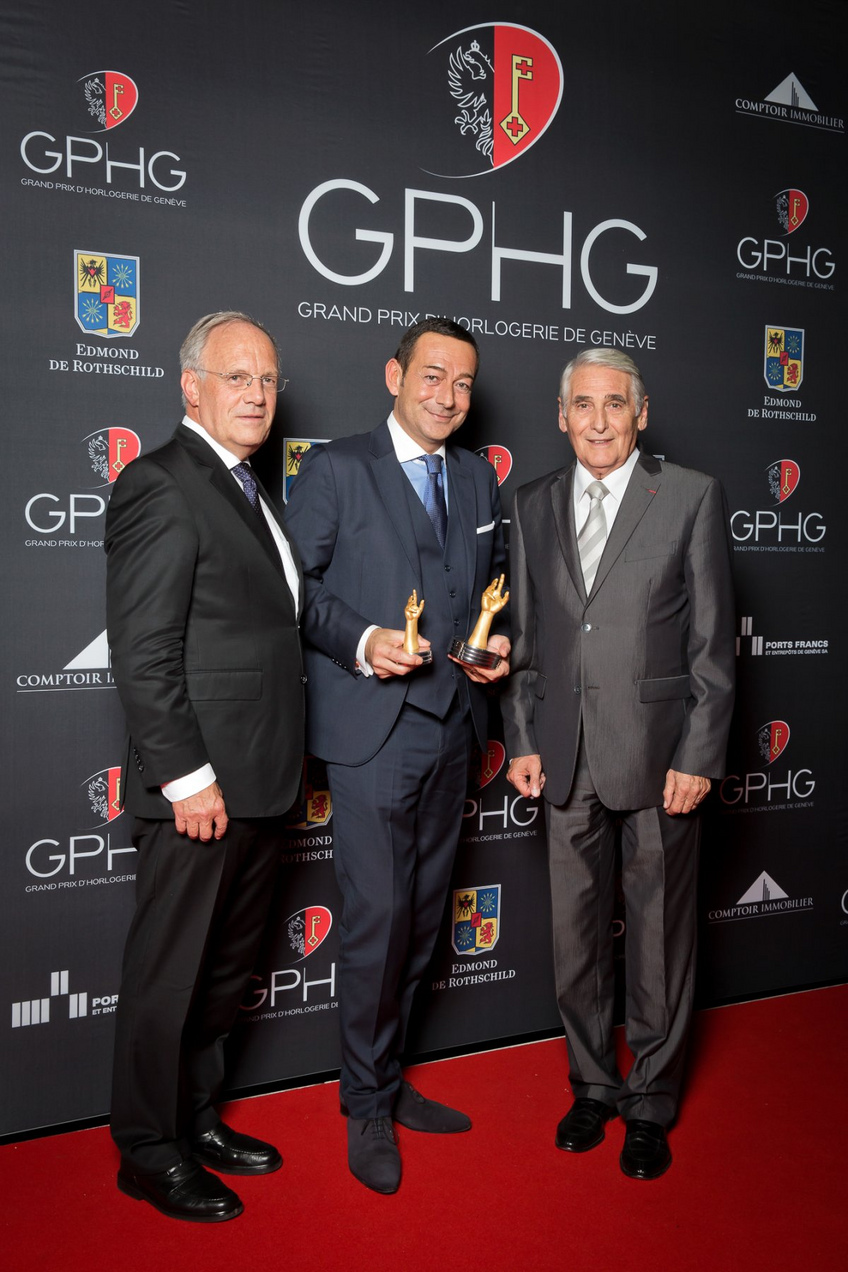
The joys of the Groenfeld brothers
Some of the winners unpacked speeches that were on the longer side and had to be called to order by the famous refrain by French singer Michel Fugain's line "Je n'aurais pas le temps" (I will not have the time…) piped in through the Grand Théâtre's PA system. Others exuded moving sobriety that revealed a great deal about their joy and emotion at receiving this coveted prize: like the brothers Tim and Bart Grönfeld, in from Holland, who clinched the industry's favor by conceiving and executing timepieces in The Netherlands that meet all standards of Swiss-made haute horlogerie.Their watches give no dial-side indication of their origins, but they are undoubtedly the most non-Swiss products filled with Swiss components.
Actually it's quite normal, because Tim and Bart, both alumni of WOSTEP – the watchmaking school located in Neuchâtel financed by the industry, whose mission is to expand the excellence of foreign watchmakers in charge of international aftersales service – stayed a little longer in our horological regions. For almost a decade, they were kingpins at Renaud Papy, a company reputed for its complications. Back in their own country to deal with the family business, they set about implementing their knowledge and skills. And so, on October 31, 2014, they inaugurated a new category devoted to the tourbillon, their incredible Parallax Tourbillon.
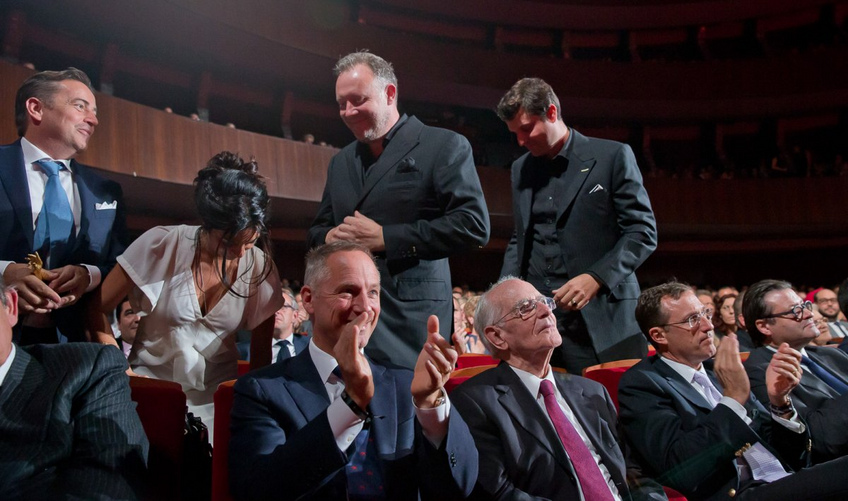
The other minimalist moment of the ceremony – where speeches are concerned – was delivered twice by Martin Frey and Felix Baumgartner, the two pioneers of what could be called nouvelle horlogerie and their brand Urwerk. They are the ones who made it to the market of micromechanical constructs that sometimes resemble unidentified horological objects and who revisit the ancient values of erstwhile giants, but always according to the rules of the art. And they innovate as well: the prizewinning watch, the EMC, a pinnacle of inventiveness, boldly blends a mechanical caliber with an electronic system capable of analyzing and correcting any variations with great precision. A kind of horological auto-regeneration.
On the social networks, the lively public relations manageress Yacine Sar was overjoyed, and her joy was echoed by the flood of likes or congratulatory commentaries. Double whammy. The EMC received both the prize for "Mechanical Exception" as well as a prize in a new category in 2014, "Innovation."
The return of the Swatch Group
As for the Swatch Group, it did well to return this year.Indeed, a fact not mentioned enough, the 72 watches entered into the competition this year had to have a candidate's dossier. This particularity of the rules, which answers any question about the "Great Absentees," contrasts with the "Watch of the Year" (Ringier), whose jury has to visit the shops and watch fairs independently to find the prizewinners.Why were some of the famous Genevan manufactures like Patek Philippe, Rolex, or Breitling not mentioned during the evening?
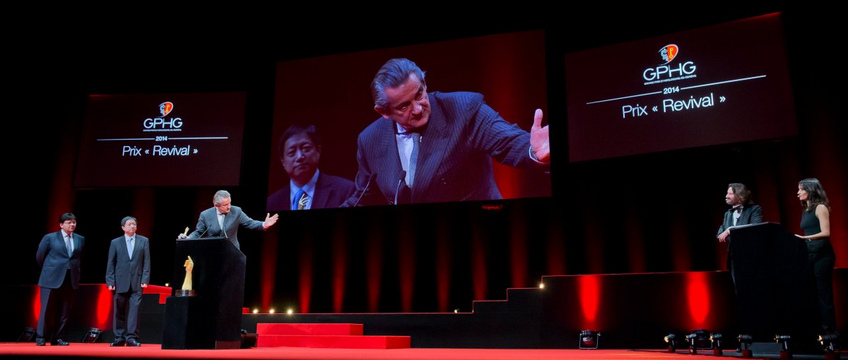
As it turned out, it was an Omega – whose boss Steve Urquhart made a rare appearance – the Speedmaster that received the top prize in the "Revival" category, first applied in 2013. Specifically, it was the Omega Speedmaster "Dark Side of the Moon," one of the models that is currently feeding the Omegamania. As for Blancpain, it picked up the Lady's Watch of the Year with its Women Heure Décentrée. Finally, the other double whammy of the evening went to Breguet for the Public Prize for the Classique Dame and the cream of the prizes, the "Aiguille d'Or" for the Classique Chronométrie.It also gave everyone the chance to test, in the space of two excellent speeches, the oratorical competencies of Jean-Charles Zufferey, director of marketing and head of media relations, since Mark Hayek was, alas, absent.
Japan and diplomacy, the Grand Prix globalizes
Were the jury aware that Switzerland and Japan were celebrating 150 years of diplomatic relations? Whatever… among the many languages spoken on the stage that testified to the diversity of the jury's geographical origins, there was some Japanese as well. In the hall, His Excellency the ambassador from Japan honored Geneva with his presence, while Seiko was granted the "Petite Aiguille" for the Grand Seiko Hi-Beat 36000 GMT (stay tuned for the article by Vincent Daveau returning from the land of the rising sun).This timepiece is admired for its exceptional technicity in spite of being in a category created for more affordable watches.
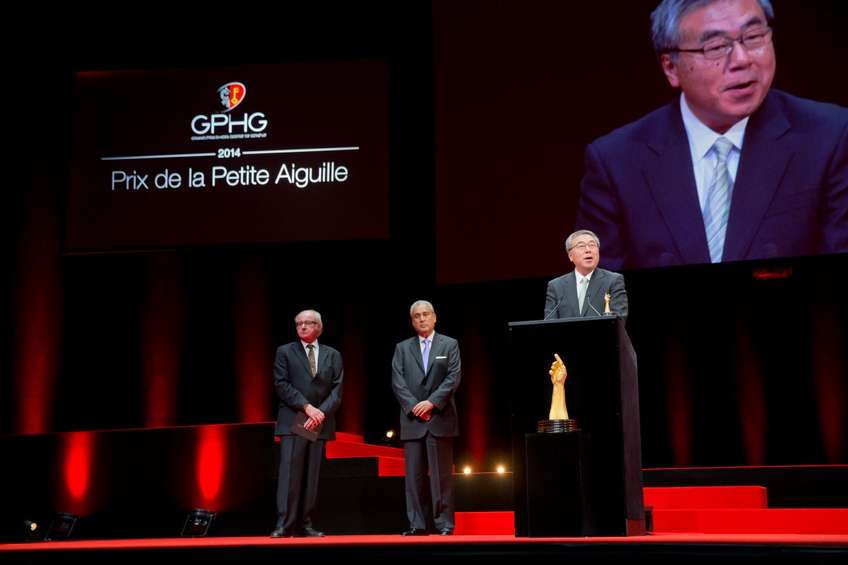
Another nod towards Japan came from the most northern of all Swiss watchmakers, the Finn Kari Voutilainen, who settled in Môtiers in the canton of Neuchâtel. His Voutilainen Hisui picked up the Artistic Crafts prize. The watch features a dial made by Unryan, one of Japan's most prestigious workshops specialized in lacquer. It is headed by Unryan Kitamura Tatsuo, the creator of masterpieces that draw on an ancient Japansese craft: "Over one thousand hours were needed to complete the dial and the bridges. Among the materials used are kinpun (gold dust) and jyunkin-itakane (gold leaf) , yakou-gai (shell of great green turban) and awabi-gai (abalone shell from New Zealand). This timepiece is inspired from precious stones, emeralds and jade, which gave it the name Hisui."
After the exhibition of the 72 watches in new Delhi and Beijing, the internationalization of the Grand Prix d’Horlogerie de Genève will continue from November 6 to 8 with a presentation of the prizewinners at the Saatchi gallery of the QP Salon in London. And so, in addition to being broadcast live by the local television station Léman Bleu, as well as on the Grand Prix's official site, the 14th edition of the event is going global in a way that even surpasses the whole process surrounding the announcement of the results.
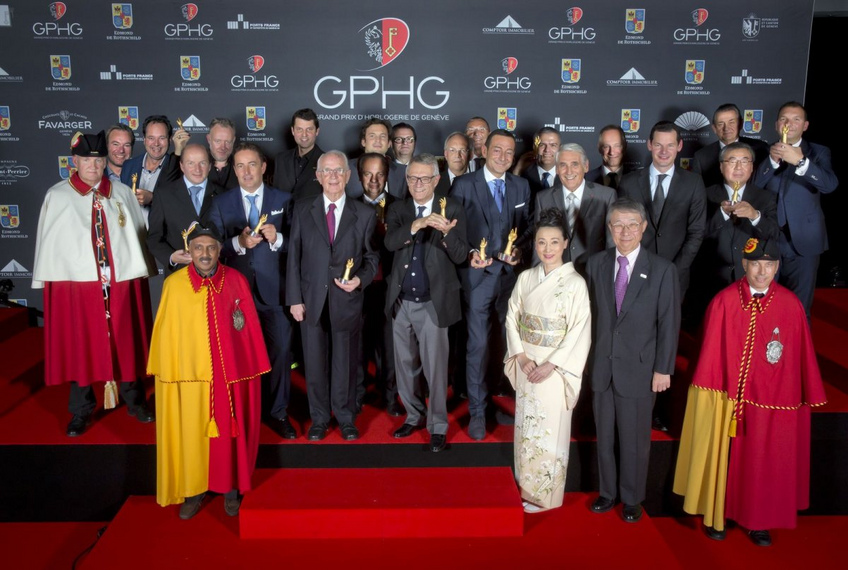
No time …
to tell you that I was enthralled by the long and emotional speech by collector Helmut Crott, the man at the helm of Urban Jürgensen & Sønner.Because I do adore the Central Second, which grabbed the Men's Watch prize, the first wristwatch carrying a detent escapement.This timepiece is in perfect sync with the Danish brand's values. The company was founded in 1773 by one of the greatest watchmakers of the time, maker of marine chronometers at the Danish court and a frequent visitor to the Jura, where his wife was born and where he acquired manufacturing sources and even took up residence.Urban Jürgensen was the son-in-law of Frédéric Houriet, Swiss Master of Chronometry.The story of this man is a must; it is described in The Jürgensen Dynasty, by John M.R. Knudsen.
…. to tell you, either, that I wondered about the absence of the brand Chopard, which in fact competed in several categories.This great independent firm, while remaining true to its family tradition in jewelry, does represent excellence in Genevan watchmaking and even has ramifications into the Jura. Its manufacture and museum are located in Fleurier, in the canton of Neuchâtel.It is also at the origin of the seal of seals, the "Qualité Fleurier" label, which covers chronometric and esthetic values as well as reliability and resistance to shocks. In sum, the German Walter Lange did merit a prize for his life and work, but nevertheless, I would have liked to see the red carpet of the Grand Théâtre being used by the Scheufele family, the most German of our Swiss watchmaking families.A shame.
…. or to tell you that I would have also expected a prize for Bulgari other than the Jewelry Watch prize, which it certainly earned with its Diva Haute Joaillerie Emeraudes.The brand did experience one of the most remarkable instances of verticalization this past decade.Without ever losing track of its iconic esthetics, Bulgari has also managed to integrate most of the watchmaking crafts, while pursuing industrial excellence combined with serious volumes. And that includes the art of the grandes sonneries, from the Vallée de Joux, or, as with the architectural Bvlgari Octo Finissimo Tourbillon, the mastery of Abraham Louis Breguet's great complication in an ultra-thin system.Yes, some regrets…


